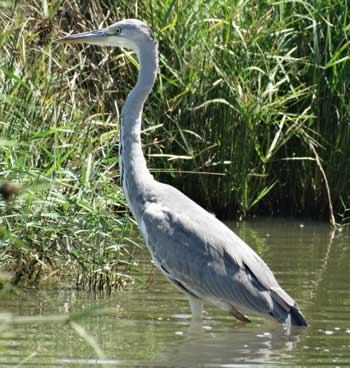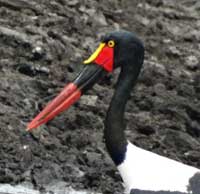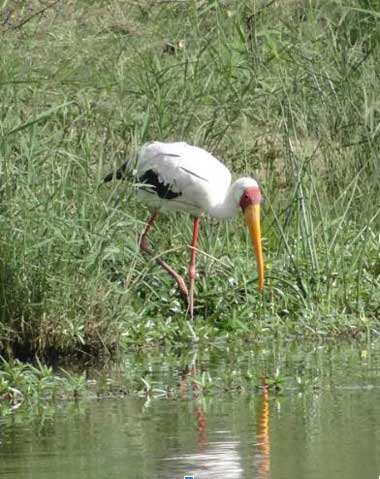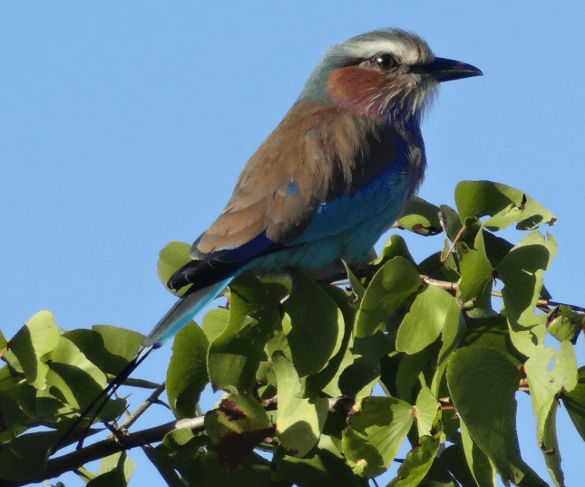SHONGOLOLO AND TSENDZE
The Shongololo Loop is a road which forms a large triangle with the main road (H1-6) to the west of Mopani. Shongololo is a Nguni word meaning ‘millipede’. (For any foreigners possibly reading this, it is pronounced ‘shawn-gaw-LAW-law’.)

We used to ignore this route because our Kruger guide book does not recommend it as a very productive one. However, on one visit to the Park when we were staying at Mopani, we decided to give it a go and, at the very least, see what the route looked like.
It turned out to be a pleasant surprise. If you have limited time, then, certainly, the Nshawu route and Capricorn Loop are a safer bet, but we enjoyed Shongololo enough to include it as a certainty for future visits. In fact, on our last visit, we did it twice!
The loop can be accessed from either the north or the south of Mopani and, on our first visit, we decided to take the northern entrance which lies some 20 plus kilometres from Mopani. The loop itself is 40 km long and it took us about four hours to complete the whole trip.

Crinum Delagoense
The very first thing of interest we saw were several clumps of incredibly beautiful lilies, which, after some research, I have discovered are crinums (Crinum Delagoense to be exact). When they have finished flowering, the ovary of each floret becomes a bulb.

Crinum bulbs
Another interesting phenomenon was the garden of toadstools which had sprung forth out of piles of elephant dung. We only had one sighting of an elephant, but the dung was evidence that there is no shortage of elephants along this route, if you get the timing right!


Shortly before 7:00 am, some twenty minutes after we had entered the Loop, we came around a slight bend and there in the road were four half-grown Black-backed Jackal cubs! This was a first for us and even if we had seen nothing else along this route, it would have made the whole trip worthwhile.
They completely ignored us, a new experience with jackals, because, usually, if you drive up to them, they lose no time in heading swiftly off in the opposite direction.
At first they stood and gazed at us calmly, and, having decided that we weren’t that interesting, they continued with their previous activities, which consisted of chasing each other backwards and forwards across the road. One of them had something and it was obvious that the other three also wanted it.
Eventually we were able to see that it was a small and very dead snake!
It was a most marvellous photographic opportunity and we made good use of it!



The snake of contention!
When we finally left, I noticed for the first time that there was a fifth cub, lying just off the road. (If you look closely at the first photo you can just make it out on the left, almost opposite the fourth cub but further up.) I commanded the driver (long-suffering husband) to stop forthwith and got my favourite Kruger shot of all time.
Why the little creature was not joining in the fun and games with its siblings was not clear. I like to imagine that it was a little girl who was tired of her brothers’ antics and was patiently waiting for mom and dad to return from their hunting expedition.


Red-crested Korhaan
Bird call (truly impressive!)
https://www.youtube.com/watch?v=fhcsxS2hvz8
Mating Ritual
https://www.youtube.com/watch?v=EI-L1XwGM64
Korhaans are to be found throughout the Park, but it was along this route that we had an excellent close encounter with a Red-crested Korhaan, to be distinguished from the Black-bellied Korhaan (now called a Black-bellied Bustard) by its smaller size, much shorter neck and the lack of a narrow black stripe running the length of its throat. I have yet to see it display its crest!
If you are interested check out the YouTube links below the photo on the left. The mating ritual is hilarious and you will see the crest clearly!

Black-bellied Korhaan
Crested Francolins are also to be found throughout the Park and the summer months often provide sightings of broods of chicks on the roads, but, as I have mentioned before, they are very difficult to photograph as they quickly disappear into the long grass growing on the verges of the roads. I was not quick enough to get the whole family but I did manage to capture three of the chicks before they disappeared.


Crested Francolin chicks above
with Mom or Dad to the left.
In summer, the various kinds of bee-eaters make spectacular appearances and it is a toss up as to which is the most beautiful. (More about them when we move further north.) We also had an excellent sighting of a Martial Eagle, but, not only was it a rather gloomy, overcast day, it was against the light, so we did not get a particularly fantastic photo.

Carmine Bee-eater

Martial Eagle

We saw only a few giraffe in two separate sightings, but the vegetation is an interesting change. Here you see more Mopani trees than scrub.

The scenery is, for the greater part of the route, quite flat, but as you approach Mopani, it does become more interesting. We always keep a sharp lookout when we come across any rocky outcrops because this is where you are most likely to find Klipspringers. However, on this trip, there were none to be seen. (More about them much later.)


Euphorbia - the Candelabra Cactus Tree.
The milky sap is very toxic.
On a subsequent trip, it was in this area that we had a fantastic sighting of a Malachite Kingfisher. Because of its minute size, I almost missed it. In the photo below left, you will see what I mean. We sat for about fifteen minutes watching as it swooped down to the pool again and again.


(On this particular trip, photography was a huge challenge. For the greater part of the fortnight, the weather was very gloomy and overcast, and, as I have mentioned before, we are amateur photographers with amateur equipment. Not only that, but hubby’s zoom was messing around - it took some effort to maintain peace and joy!)

A lone buffalo bull on the road seen from a side loop off the road up a hillside close to the Pioneer Dam.

To the left is a close-up of the lone bull seen above.
His ragged ears, drooping eyes and lined face spoke of advanced age, but what was most intriguing was how he tolerated the intrusive oxpecker which was practically crawling up his nose!
This is a Yellow-billed Oxpecker. (More about the two kinds of oxpeckers much later when we go to Shingwedzi.)
We have reached the last few kilometres of the Shongololo Loop, which skirt the Pioneer Dam, and are approaching the Tsendze River.
The low water bridge over the Tsendze River almost always provides opportunities for good bird sightings. (We have often come here as it is not even a kilometre from the H1-6 and is only about 5 km from Mopani itself.)

View of the Tsendze downstream

Upstream - the lower end of the Pioneer Dam


Goliath Heron

Grey Heron

Male Saddle-billed Stork

Above is a head shot of a female, taken near Satara.
Note the differences:
The eye of the female has a bright yellow iris, while the male eye is brown.
The male has bright yellow wattles (see just below the upper red part of the beak). The female has no wattles.
I was spoilt for choice with regard to the photos of the Black Stork. It was very close to the bridge and it posed most obligingly! I chose two to show that, while from the back it is indeed a black stork, a side or front view reveals that it is a black & white stork!


The same applies to the Pied Kingfisher. It was sitting on reeds close to the edge of the bridge so we got our best shots ever of this beautiful bird. However, the crowning delight came later that afternoon when we returned to this spot and I was able to get this great shot of the elusive Black Crake which is a shy and restless bird.

Pied Kingfisher. This is a female. The male has a double band across the chest.

Black Crake


It was also here that we at last got up fairly close to a pair of Yellow-billed Storks. One was feeding in the reeds on the opposite side of the dam while the other was resting on the banks, apparently unconcerned about the presence of its enemy in the shallows nearby.
I mentioned that we had one elephant sighting on the tour of the loop, but the photo I want to use was taken on our very first visit to this spot, when we had just crossed back over the Tsendze bridge.
He advanced towards us quite quickly so we didn’t stay around to get more photos! Broken tusks seemed to me to speak of a very aggressive nature, but we have since learnt what the signs of musth are and when to be particularly careful. (More about that in a later chapter.)

The low-water bridge over the Tsendze is a short distance from the H1-6, but instead of going back to Mopani, we turn right in the direction of Letaba to follow the course of the Tsendze River, which is now on the right. (See the map below.)
There is a series of small loops which take you right to the river, but we have never found them to be that productive of sightings. We have seen more on the H1-6 itself along here. (More about that further on.) The only small loop which really interests us is the one to the Mooiplaas Picnic Spot (not to be confused with the Mooiplaas Waterhole), because by now our bladders have almost reached bursting point!

Some 8 km further along the H1-6, we reach the northern entrance to the Tsendze Loop, the S48, which is approximately 17 km long and follows the Tsendze closely for most of its distance. Our guide book declares this to be a good area for sightings, especially for lions. In fact, the author claims that he has yet to drive this road without seeing lions!
This has not been our experience. Also, there are not that many clear views of the river. However, that being said, if you have the time, it is an interesting drive and because of the proximity of the river, you are bound to see something!
Below is one of the few clear views to be had of the river itself.

We come now to one of the most unusual impala sightings we have experienced in the Park, seen in the month of May, some five to seven months after the lambing season. We can deduce, therefore, that the young ram on the left is approximately six months old, whereas the one on the right must be from the previous season.


Now look at the photo below - the suckling ‘lamb’ is practically the same size as his mother. The close-up of his horns shows that he is about the same age as the year-old ram above!

The only reason I can think of for this is that his mother lost the latest season’s lamb to a predator, so he was not displaced by a younger sibling.

One of the most elusive of the small antelope is the Common Duiker. It is approximately 50 cm tall at the shoulder and weighs about 20 kg. It is certainly one of the shyest of the antelope - even more so than the bushbuck. Like the bushbuck, it is never seen out in the open. Thick bush and riverine vegetation is where you need to look out for them.
The two photos below left are typical of what you are likely to see - the rear end of the little creature as it scoots out of sight! So, once again, I am going to cheat. On the right is the best photo I have ever managed to get of this beautiful animal. We were on the H1-2, just north of Skukuza. We came around a corner, saw it, stopped, I aimed, clicked, and a split second later it was gone!



One of the most puzzling sights I have seen in the thick bush are these humungous spider webs.


I am not a spider lover and every time I’ve seen one of these my imagination has gone into overdrive. I mean, can you imagine the size of this spider? And what has it wrapped up in the centre? Is it some hapless bird or small mammal which is going to be food for all the baby giant spiders? Or is it an egg ‘packet’ containing countless babies? And imagine walking into one of these as you stride through the bush. What if the giant spider takes exception to being disturbed? A spider this size could probably swallow you in one gulp! Okay, maybe I’m exaggerating. Let’s say three or four gulps.
Well, it turns out this is the web of Community Spiders! What looks like the egg packet is actually the nest! It consists of a series of tunnels in which hundreds of these spiders all live together in apparent harmony.
We also saw some giraffe, Waterbuck, zebra and elephant along this route, but there have been two occasions when we saw almost nothing. The length of this loop means that it is a long time to see nothing, which is why it is not one of our favourite drives. However, I readily concede that we may just have been unlucky, or chose the wrong time.
What I did manage to capture here was one of my favourite shots of a Lilac-breasted Roller, which was sitting on a mopane bush. As I have mentioned before, the rollers are so accommodating. They always perch on an exposed branch or stump, the only movement being their heads as they search out their next meal. Then they either swoop up into their air or down onto the ground, after which they immediately return to the same spot or one close by to consume their catch. Your chances of getting decent photos are, therefore, very good.

We reach the end of the loop and find ourselves back on the H1-6 opposite the Malopenyana Waterhole. Turning north, back towards Mopani, we travel another fifteen kilometres or so (passing Middelvlei) before finding ourselves back at the northern entrance of the Tsendze Loop. Another 12 km brings us back to the southern entrance of the Shongololo Loop. We have seldom seen much along this route, although the chances of seeing elephant are good.
Our most unusual sighting along here was of a pair of Steenbok. These tiny antelope (about three quarters of the weight of the Common Duiker) are solitary animals. If you see two of them together, it is probably a mother with her lamb. With these two below, we were positive we had stumbled onto a breeding pair. The ram looked mature and he was sniffing very interestly at the ewe’s nether regions. (More about Steenbok later.)



Another two kilometres brings us to the turn-off to the Mopani Camp.
We have often seen elephants along here but our favourite photo is of a baby elephant which we were really lucky to capture. The mothers are extremely protective and tend to shield their babies, very much getting in the way of cameras! On this occasion, the mother moved off into the mopane and left us just enough time (and space!) to get the baby on its own.
We end off with an elephant sighting which we had very early one morning. This was on the turn-off road to the camp, very close to the H1-6. It was at the height of the rainy season, so if you happen to visit during the dry season, the ditch will be dry. However, it does, for quite a while after the rains, provide wonderful mud for those animals that like to wallow!

This brings us to the end of our drives around Mopani and we will now leave for an extended tour of Shingwedzi!